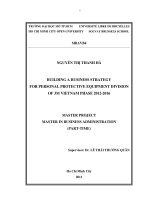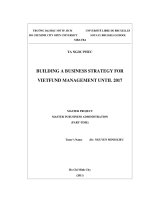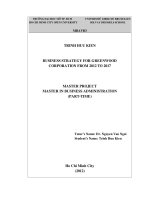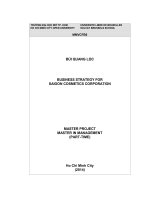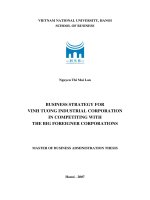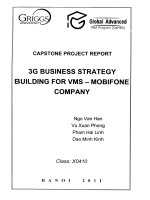BUILDING 3g BUSINESS STRATEGY FOR MILITARY TELECOMMUNICATIONS CORPORATION
Bạn đang xem bản rút gọn của tài liệu. Xem và tải ngay bản đầy đủ của tài liệu tại đây (930.57 KB, 115 trang )
THESIS MBA
BUILDING 3G BUSINESS STRATEGY FOR MILITARY
TELECOMMUNICATIONS CORPORATION PHASE 2010 - 2015
1
HA NOI, 2009
CONTENT
2.2. SWOT Matrix for Viettel................................................................................................4
CHAPTER I: THEORETICAL BASIS.................................................................................9
1. Business strategy:...............................................................................................................9
1.1. Concepts of strategy, business strategy:..........................................................................9
1.1.1. Concept of strategy: .....................................................................................................9
1.1.2. Business strategy concept:..........................................................................................10
1.2. Features of business strategy:........................................................................................11
1.3. Role of business strategy:..............................................................................................12
2. Process of business strategy management:.......................................................................13
2.1. Current situation analysis:.............................................................................................13
2.2. Strategy building:..........................................................................................................13
2.3. Strategy implementation:..............................................................................................14
2.4. Strategy evaluation:.......................................................................................................14
3. Main issues of business strategy building:.......................................................................15
3.1. Requirements for business strategy building:...............................................................15
3.2. Principles of business strategy building:.......................................................................15
4. Determining tasks and system of strategic targets:..........................................................17
4.1. Strategic tasks:...............................................................................................................17
4.2. System of strategic targets:............................................................................................17
4.3. Principles of target determination:................................................................................18
Model of 5 competition forces :...........................................................................................27
6.4.The junction between business strategy and other strategies :.......................................41
6.4.1. Corporate-level strategies: ........................................................................................42
6.4.2. Business strategy ( competitive strategy)...................................................................42
6.4.3. Functional strategies (operation strategy)..................................................................42
7. Methods analysing strategy selection:..............................................................................43
7.1. The BCG growth share matrix......................................................................................43
7.2. McKinsey matrix - GE (General Electric):...................................................................45
III Business strategies for 3G services from 2010 - 2015...................................................98
2
ABBREVIATIONS
Production and Business
-
PnB
Company
-
Comp
3
TABLE CONTENT
1.1.
Macro environment analysis
1.2.
Typical factors that affect competitive strength
1.3.
Typical factors that affect market attractiveness
1.4.
SWOT matrix
2.1.
Business and production outcomes phase 2004 – 2009
2.2.
SWOT Matrix for Viettel.
3.1.
The number of subscriptio for recent years
3.2.
Expansion of subscription using GSM technology for recent years
3.3.
Prediction of the number of subscribers in Vietnam
3.4.
Proposes the number of 3G subscription of Viettel in the 1st, 3rd, and
6th year
4
CHART CONTENT
1.1.
Simulation of the company’s business environment
1.2.
External environment
1.3.
Force model of M.PORTER
1.4.
Model of value chain
1.5.
BCG growth-share matrix
2.1.
Basis for selecting business strategy.
2.2.
The growth rate figure in years
3.1. The estimation figure for The development of mobilephone subscribes in
the world
3.2. The estimation figure for The development of GSM mobile subscribes
in the world
3.3. The growth rate figure the WCDMA subscribers
3.4. The growth rate figure of subscribers
3.5. The figure for the revenues density of speech services and non-speech
services
3.6. Revenue graph due to subscriber types
3.7. The estimation figure for the growth rate figure of subscribers in Viet
Nam
3.8. Distribution channel model of Viettel.
5
INTRODUCTION
1. Subject selection reasons
In recent years, mobile phone market has been blooming. There are 7 service
providers in operation, some others are taking application procedures for entrance.
However, the market is getting to saturated point. Competition is becoming fierce.
Growth of revenue, profit is weak. These urge companies to have new strategies for
development. In this scene, 3G (a set of international telecommunication standards
and technologies promoting mobile phone quality and efficiency) turns out to be a
solution for companies.
Viettel is the one to have a big market share in Vietnam telecommunication
market and a pioneer in 3G service building and providing. To implement business
well, it is needed to have a correct, proper business strategy for company’s
capability and appropriate to current features of Vietnam market.
In recent years, Viettel has got business strategies which are definitely right
and obtained outstanding results as so called magically in mobile phone business
(2G) not only in Vietnam but also abroad. However, 3G is a new service, full of
challenges for all telecom companies in Vietnam, because it is a right business
strategy and an urgent need.
With the wish of applying learned knowledge into practice at the place
whereas there is a group member working for, the group has selected the subject
“Building 3G business strategy for Military telecommunications Corporation phase
2010-2015” to be research subject for the group.
2. Research purposes
-
Researching and systematicalizing theories about building and
implementing business strategy, selecting analysis models efficient to business strategy
building and implementation.
6
-
Applying system of above theoretical basics and models for analysing and
evaluating internal, external environments in order to build 3G business strategy for
Military telecommunication corporation.
-
Recommending
solutions,
suggestions
in
business
strategy
implementation in order to complete the corporation’s selected business strategy.
3. Subject research criteria
Due to time and resource limitations, our group only had deep research in
analysing and building strategy of 3G business (one of Viettel’s businesses) for the
corporation phase 2010-2015, the key period for development and success of the
coporation’s 3G service.
4. Research methods
To solve the above issue, the report mostly uses method of qualitive analysis
(analysing facts of Military telecommunication corporation). The specific methods of
data collecting such as investigation sheet, expert interview have been used to collect
data. Using national statistic records, professional information, data; using secondary
data
on
strategy
and
researches,
reports
previously
done
by
Military
telecommunications corporation.
5. The report includes:
Introduction
Chapter I: Theoretical basic:
Concerning theoretical basics of business strategy such as: concepts, nature
and basic features of strategy and business strategy. Some of business external
environment analysis models in building business strategy: 6 factors of external
environment, 5 competition forces. Some models are used to analyse the company
internally in building business strategy: model of value string, sustainable
7
competition advantage, general model of internal and external environment analysis
(SWOT).
Chapter II: Analysing Viettel’s strategic factors and activities phase 20042009
General introduction of Military Telecommunications. Models are applied to
analyse the company’s internal and external environment. SWOT model is applied to
generally evaluation finding the company’s strengths, weaknesses, opportunities and
threats.
Chapter III: Recommending 3G service business strategy for Viettel
phase 2010 – 2015 and implementation solutions
General introduction of 3G. Recommending 3G business strategy for Viettel
phase 2010-2015 and some solutions in order to implement successfully selected
business strategy.
Conclusion
Reference List; Appendix.
8
CHAPTER I: THEORETICAL BASIS
1. Business strategy:
1.1. Concepts of strategy, business strategy:
1.1.1. Concept of strategy:
There are many definitions of strategy. Each has differences upon author’s
own point of view.
Strategy is related to definitions of competition advantage and
organization’s control of resources such as human, properties, finance, in order to
develop and ensure its vital benefits. Kenneth Andrews is the first one giving out
this outstanding idea in the classical book The Concept of Corporate Strategy.
According to him, strategy is what an organization should do based on its strengths
and weaknesses in the scene of having both opportunities and threats.
According to Chandler, strategy is “determination of the company’s long
term basic targets, purposes and series of activities as well as assignments of
resources to process these targets” (Chandler, A. (1962). Strategy and Structure.
Cambridge, Massachusetts. MIT Press).
Bruce Henderson’s concept, strategist as well as founder of Boston
consulting Corporation: “Strategy is a careful search of action plan to develop and
join the organization’s competition advantages. The difference between you and
your competitors is the foundation for your advantage”.
(Source: Efficient business plan, Harvard Business Essentials, Hochiminh
City’s general publishing house, page 10).
Michael E. Porter’s opinion, the leading strategy professor of Harvard:
- “Strategy is the creation of position that is unique and valuable, including
different groups”;
9
- “Strategy is to carry out the balance of different factors to get the best
combination in competition. The nature of strategy is to decide what does not need
to be done”;
- “Strategy is the creation of harmony within company’s activities”.
(Source: Michael E. Porter, “What is Strategy?” Harvard Business Review,
November, December 1996, page 68, 70, 75)
So, what is strategy? Strategy is a plan to bring to the company a
competition advantage against competitors. Strategy is to understand the targets of
what the company are doing, focusing on planning how to achieve those. “Strategy
is a series of complex actions to mobilize resources that an organization can have to
achieve certain purposes”.
Strategy has strongest impact when its core is the company’s values which
have been understood clearly: what are priority criteria on aspects of product,
customer, supplier, investment, shareholders and business environment... Strategy is
not a singly management process, but one included with commitments to
company’s decisions and activities in order to get competition advantage.
1.1.2. Business strategy concept:
According to Boston consulting corporation: “Business strategy is the
determinations of available resources allocation with purpose to change competition
balance and turn advantage to our side ”.
According to Michael E. Porter: “Business strategy to cope with
competition is combination between targets which need to be achieved and tools
that company needs to find to achieve the targets ”.
The concept of business strategy as Strategic management textbook of
Griggs is: a series of commitiments and actions that used by a company to get
competition advantage by exploiting core capabilities in a certain market.
10
Business strategy for a company is an art of building long term targets and
implementation policies to orientate and create competition advatage for the
company.
Totally, business strategy lets us understand:
- Where the company is trying to get to in long term (orientation).
-
What market the company is competiting in and activities the company
is carrying out on that market (scale market)?
- How the company will do to operate better comparing to its opponents
on the market (advantage)?
- Which resources (skills, assets, finance, relations, technic capabilities,
equipments) need to have in order to be able to compete (resources)?
- How external environment factors affect the company’s competition
ability (environment)?
- What values and prospects the power holders outside and inside the
company need (capital contributors)?
( Source : www.Saga.vn )
1.2. Features of business strategy:
Although there are many different opinions and approaches on the term of
strategy, main features of business strategy are concepted unanimously. The
features are:
- Objectiveness: business strategies often determine the fundamental
goals, the business orientation of each enterprise in each period and policies to
implement the objectives set out.
11
- Appropriateness: this requires the company when building business
strategy, to evaluate precisely facts of its business performances. In the mean time,
it has to regularly revise and adjust to fit to environmental changes.
- Orientation, long-run: business strategy is built for long period (5 or 10
years). Thereto, business strategy has character of route and is concretized by
strategies with shorter term, so called plan.
- Flexibility, elasticity : business strategy is built on the basic of future
market forecast, thus, strategy should be flexible, elastic upon market fluctuations.
- Continuousness: Business strategy is a continuous process from building,
implementation organisation, checking, supervising to strategy adjustment.
- Competitiveness : Business strategy, nowadays, cannot be separated
from competition because business strategy partially ensures the company’s
capability to compete on the market.
1.3. Role of business strategy:
Business strategy plays a very important role in survival and development
of every company. Right business strategy will create a good way for the company.
Business strategy can be deemed to be guideline for the company heading on the
right direction. Business strategy brings back many profits for the company. Its
importance is prooved as in the following aspects:
- Helping the company orientating its activities in the future through
business environment analysis and forecasts.
- Helping the company hold oppotunities as well as threats to development
of the company’s resources. It helps the company exploite and use properly all
resources, prove the company’s strengths.
12
- Strategy creates an operation orbit for the company, helps the company
unite personals with different benefits heading to a common target, to develope the
company.
- Business strategy is efficient competition tool for the company.
2. Process of business strategy management:
In the process of strategy management, the manager carries out series of
following actions:
2.1. Current situation analysis:
Before deciding orientation or proper strategy reaction, it is required to
analyse current situation. Situation analysis requires consideration of organisation’s
background, aspects of organisation’s external and internal environment:
- The company’s internal factors themself : strong or weak.
- External environment factors : opportunities or threats to the company.
- Leader’s wishes: company value, prestige and competition advantage.
2.2. Strategy building:
Strategy building includes design and selection of appropriate strategies for
the organisation. To do these, it is necesseary to consider from many organisational
levels and set up different strategies:
- Company strategy: it relates to overall target and scale of the company to
satisfy capital contributors’ expectation. Any change in the organisation’s structure
of business fields can change company strategy.
- Competition strategy: considering how the organisation competes in a
certain business field or industry. It relates to strategy decision for product
13
selection, customer satisfication, obtaining competition advantage against
competitors, exploiting and creating new opportunities …
- Functional strategy: it is decisions and activities guiding targets which
are built for short term period for different functional units in an organisation. It
relates to how every parts in the company shall be organised to implement strategy
orientation at the level of company and every part in the company. Thus, functional
strategy focuses on issues of resource, handling process and human.
2.3. Strategy implementation:
Strategy implementation is the process bringing organisation’s different
strategies into implementation. Measures implementing different strategy levels are
attached closely to strategy building.
2.4. Strategy evaluation:
Final stage of strategy mangement is strategy evaluation. All strategies
depend on future changes because internal and external factors keep changing. 3
main activities of this stage are:
- Reconsidering factors as basics for current strategies,
- Measuring achieved outcomes,
- Carrying out adjustments.
Stage of strategy evaluation is necessary because present success will not
guarantee future success. The success always create new issues. The organisations
with thingking of satisfication shall have to pay for collapse.
14
3. Main issues of business strategy building:
3.1. Requirements for business strategy building:
- Business strategy must be stick to market:
- Business strategy building must be count with safety in business, risk
minimization.
- Key targets, strategic business area and basic conditions to achieve those
targets must be verified.
- Business strategy must show the harmonious combination between 2
types of strategies : general business strategy which contains general covering
issues that are most decisive, and partial business strategy including issues of
partiality such as product, price, marketing, promotion strategy.
- Business strategy must be presented by specific targets, having
feasibility with purpose of getting maximum result in production and business.
3.2. Principles of business strategy building:
As stated by Michael E. Porter at the seminar “Global competition and
Vietnam advantage - 1/12/2008”, when building business strategy, the company
needs to follow 5 following principles:
- Determining clearly a group of typical values which shall be shown to
customer, have unique characters against the opponent’s,
- Determining a string of different values and adjusting it as customer’s
expectation,
- Determing clearly balance and exchange (choosing what not to do),
15
- Confirming that activities in value string must be fit, consistent with and
supplementary to one another,
- Ensuring continousness of strategy with regular improvements in
strategy implementation.
The first important step of strategy building is to determine organisation’s
activities. The core of determination is to answer the question : what are our
business activities? To answer this question, Derek F. Abell suggested that the
company should determine its business activities on 3 aspects:
- Who will be satisfied ? (which customer group ?).
- What will they be satisfied with (what do customer want?).
- Way to satisfy customer demands (what different skills, capabilities?).
Customers: finding and attracting customers are usually the most importat
target of a company. With customers, the works as product development,
production expansion, goods distribution ...will become nonsense. Thereto, analysis
of external factors is often started with custumer researching. Customers are
regularly divided into groups with common features. Market segmentation is to
segment a big and unidentified market into smaller segments with many identified
features.
Determining customer needs that should be satisfied: customer needs
regularly relate to benefits and specifications of product ; are their expectations with
characteristics and efficiency capability of the product.
Determing core capabilities neccessary to satisfy customer needs: core
capabilities are foundation for all new strategies or adjustment. Companies use core
capabilities to implement strategy creating values to satisify customer demands and
only the ones with capabilities that are improved continuously, renewed and
developing their internal forces will expect to satisfy or overcome customer
16
expectation through time. However, core capabilities must be unable to be copied,
long term, sustainable, suitable capacity, having competition advantage.
4. Determining tasks and system of strategic targets:
4.1. Strategic tasks:
It is a fixed statement on long term about the company’s purposel. It
distinguishes one company from the others. The statement could be business
principles, purposes, business philosophy, based on which business field of
products and services, market demand will be determined.
Content of strategic tasks shows overall issues, on which the company’s
operation area in product aspect and market will be determined. When defining
strategic tasks, it is needed to pay attention to factors : establishment history,
leader’s desires, business environment conditions, available resources and the
company’s strong points. Strategic tasks help leaders determine easier, more
specifically. It determines the company’s priority level in order to evaluate
potentiality of each business unit and draw future direction for the company.
4.2. System of strategic targets:
Strategic targets: target is future status that the company tries to carry out or
the final result of arranged activities. Target is found out directly from task function
but more specifically and clearly, quantitated into numbers : growth rate, profit rate,
revenue, market share. Strategic targets can be separated into 2 types : long term
and short term.
- Long term targets: are expected result set forth for a long period of time.
According to Peter F. Drucker, company’s long term targets relate to 7 fields as
follows : profit level, productivity, competition position, job creation, members
relation, technology leading position, social duties.
17
- Short term targets: are specific results that the company intends to achieve
in a short period of time. Short term orientation may distract management activities,
e.g. cutting cost for investments that the company thinks they are not necessary in
short term such as expense for R&D, marketing… This leads to insufficient
investment, lack of improvements and weak market awareness jeopardizing
investment capital market in long term.
4.3. Principles of target determination:
- It should be clear in every stage of the company’s development;
- It has attachment, supplement to one another. One target does not obstacle
the others;
- Prior targets must be determined, showing classification of targets, set
tasks for the company in each period.
Target of business strategy will be deemed to be right when it is given out to
every management level of the company and ensuring following features:
-
Being precise and measurable: if the target is not determined precisely
and immeasurable, the process orienting to the target cannot be considered by the
company. Measurable target provides managers with standards for consideration of
their implementation.
-
Target must head to important issues: to maintain concentration, the
company should perform with some targets. Thus, selected targets should be
important targets.
-
Target can have challenges but be processed: target challenges managers
as a motivation to find out improvement methods for organisation’s operation. But
it is not realistic, cannot be implemented, the staff will reject it. Vice versa, too easy
target can not encourage managers.
18
-
Target should be determined with a period of time to achieve: Time
constraint is important because it states that success must be assured to be in time,
not after that.
-
Target of consistency: Consistency means that strategies must fit to one
another and be consistent and that the completion of one target will not obstacle the
others.
5. Analysis of the company’s business environment:
Analysis of business environment including macro and micro environments
to determine opportunities and threats to the company. It is the process considering
different environment factors and determining the impact from opportunity and
threat, by which opportunities will be taken, threats to the company will be
controlled.
19
Chart 1.1: Simulation of the company’s business environment
Macro environment:
Economic factors
Politics, legislation factors.
Macro environment includes external
factors affecting the company.
Operation environment includes
factors outside the company,
guiding competition in the
industry.
Internal environment includes the
company’s internal forces.
Socio-cultural factors
Demographic factors
Technology factors
Operation environment
(industry)
Globalization
factors
Competitors
Customers
Suppliers
Potential opponents
Substitution products
The company’s internal environment
Human resource
Research and Development
Production
Finance, accounting
Marketing
Organisation custom
5.1. Analysis of macro environment:
The company’s objective environment includes 6 partitions: economy,
politics and legislation, socio-culture, demography, technology and globalization.
Changes in macro environment can affect directly to any forces in the industry.
Thus, it change relative strength to other forces and itself, and finally, it changes the
attractiveness of an industry.
The company must realize opportunities, threats brought by objective
environment which the company has to get used to and also press for environment
changes. Factors of macro environment are shown by following model:
20
Chart 1. 2: External environment
Economy
Demography
Industry’s
environment
Socioculture
Threats from new companies
Supplier power
Buyer power
Threats from substitution
Competition intensity
Competition
Environment
Politics
/legislation
Globalisation
Technology
Source: Strategy management textbook – Gemba01.01
5.1.1. Analysis of economic environment:
Economic environment is socio-economic situation and economic policy in
the country where the company exists and develops. Economic environment
includes: socio-economic structure, level of economic development and macro
economic policy...
Analysis of socio-economic structure: socio-economic structure is also called
the structure of national economy, including the structure of: industry, distribution,
exchange, consumption, techniques, ownership etc… among which development
21
strategy of industries is the most important factor. Thereto, when building business
strategy, the company must study development situation of industries that the
company is doing business in.
Analysis of economic development level: economic development level is
scale, speed of economic development for a country, region and obtained economic
level. Criteria representing economic development level include GDP, national
income, national income per people, economic growth rate. Analysis of economic
development level can help the company hold the development trend of the
economy.
Analysis of economic institution: economic institution is the form of
economic organization of a country. It regulates the relation between government
and companies, companies and companies, companies and economic industries. Via
certain administration tools, methods which are used to harmonize affect scale,
content, methods of socio-economic activities. It sets forth principles and basic
conditions with system of form, content, way of the company’s survival and
development.
Analysis of government’s economic policy: economic policy is target of
economic development in a specific period of time stipulated by the government
with strategies, policies to achieve that target. Economic policy of a country
includes economic development strategy for whole country, industry policy,
distribution policy, price, commerce, salary, finance and monetary policies, interest
rate, exchange rate, inflation rate... Macro economic policy regulates scale and
operation principles of companies, harmonizes relation between companies,
industries, partially and wholly, ensures normal running of national economy,
implementing target and mission of national economy development.
5.1.2. Analysis of politics and legislation environment:
22
Politics, legislation environment includes: political regime, government
institution, regime of political party, organizations, legislation system... Factors of
politics, legislation impact on the company’s development strategy in different
ways. They may be opportunities for one company, but also threats to the others.
Open policy encourages many economic elements to take part in production and
business activities. This is the threat for state owned enterprises but an opportunity
for private companies joining the market.
Impact of politics and legislation environment to the company’ business
activities are deep and wide, and even decisive. General, if a country is stable in
politics, clear and consistent policies, strict legislation, companies can develop
healthily and stably.
5.1.3. Analysis of socio-culture environment:
Social environment: it includes foundation and fluctuation of society classes,
population structure, population imigration, social power structure, people work and
live custom. Facts and fluctuation of these factors can affect the company’s
business.
Cultural environment: it includes factors of philosophy, religion, language,
literature, art. Impacts of these factors to the company’s business are mostly indirect
but cannot be underestimated.
For strategy management, factors of socio-culture are sensitive and changing
regularly. Living custom of people automatically changes along with newly adopted
trend of life that leads to change of consumption behavior. High people intellect
results in customer increasing demand of high production quality and. This is a
challenge to the producer.
Every company is operating in certain socio-cultural environment. Society
provides resources the company needs, consumes products and services the
company makes. Socio-cultural environment can affect strategic decisions such as:
23
goods and field selection, brand selection, color, design, change of distribution
channel.
5.1.4. Analysis of demographic environment:
Population scale: observation of demographic change on population would
raise the importance of this partition. Forecast of population will reveal global
challenges about population of 21st century and opportunities for businessman.
Age structure: It reveals opportunities of old people care services, insurance
services. However, it also hides a challenge to companies about labor resource.
Geographic allocation: this can create advantage for telecommunication
technology. By computer, human can stay at home and communicate with the
others via telecommunication.
5.1.5. Analysis of techniques and science environment:
Techniques and sciences environment: it is the factor of techniques and
science and a collection of social phenomena directly related to techniques and
science at place where the company exists and develops; government’s scientific
institution; policy of techniques and science and legal documents on techniques and
science.
Science and technology are the most important factors of the company’s
technical and science environment. It includes areas of science and technical which
have been researched and successfully researched, advanced techniques and
science, utilize of technical and scientific achievements. Social force of techniques
and science is the real strength of technical scientific research and development for
a count or a region. Technical scientific institution of a country regulates structure,
operation mode of national technical scientific system and its junction with other
parts of national economy. It includes social position of technical scientific career
and officials, principles of establishing and operation mode of technical scientific
24
agency, technical scientific management policy, and application channels of
technical scientific achievements. All these factors effects in many aspects to the
company’s business and management.
Nowadays, world technical and science are improving quickly. Developing
countries have stepped into the age of know-hows economy. Know-hows keep
changing. New techniques have been born and applied so quickly that it made
whole economy of developing countries intellectualized. It will change the
company’s environment of technical and science promotes reform of society’s
techniques and science, urges for technology transfer and current industry structure.
The companies need to recognize brightly that change and hold the chance brought
by it, carry out technical advances and upgrade their own techniques.
5.1.6. Global environment:
Global environment includes related global markets, present changing
markets, significant political issues, and basic institutional and cultural
characteristics in global markets.
The companies without direct transactions with foreign partners still need to
concern about impact possibility of international environment because it affects
indirectly them through macro and micro environments.
- Impact to economic environment: every fluctuations of world economy
have certain effects to the economy of every nation at different levels. Economy
development of one nation effects to that of the other and has relation with world
economy.
-
Impact to politics and legislation environment: based on diplomatic
relation between governments, the relation of trading on international market is
founded. Any change in diplomacy will result in adjustment of foreign affairs
economic policy and this adjustment has impact directly or indirectly on the
company.
25
